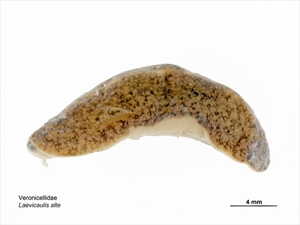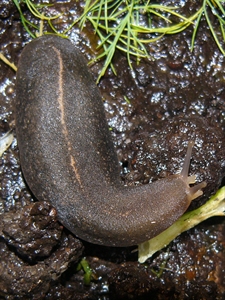Tropical leatherleaf. It is also known as the lined leatherback slug, brown slug (in India), or black slug.
Pacific Pests, Pathogens, Weeds & Pesticides - Online edition
Pacific Pests, Pathogens, Weeds & Pesticides
Tropical leatherleaf slug (475)
Laevicaulis alte; previously known as Vaginula alte, and Veginullus alte.
Asia (southern parts, and Indian Ocean), North America (Hawaii), Oceania. It is recorded from Australia, American Samoa, Fiji, French Polynesia, New Caledonia, Papua New Guinea, Samoa, and Vanuatu.
In keeping with many other land slugs and snails, this species feeds on a wide range of plants, as well as decaying organic matter.
A pest of vegetables, fruits, ornamentals, forestry species, and especially seedlings. The slug has no shell, and the mantle covers most of the body, which is dark, leathery, sometimes mottle-coloured, with small pimples. It is about 70-80 mm long (but up to 120 mm) when moving, round when contracted (Photos 1&2). There is a thin yellowish line running the length of the back (Photo 3). The anal opening is a crescent-shaped slit with a pale border. Unusual for slugs, it has a narrow foot: 1 mm wide when immature and 4-5 mm wide when mature. Tentacles are small, the upper pair 2-3 mm long, almost covered by the mantle.
Eggs are laid in clusters of up to 100 in a hole or depression in the soil, covered with feacal material and soil to prevent desiccation; they hatch after about 1-3 weeks and the young (called juveniles) search for food at night, and stay buried in soil during the day. Mature slugs (sexual maturity is reached at about 7 months) are sometimes active during cooler times of the day as well as night. Note that individuals are first male and then female, and they can self-fertilise.
Mature slugs are found under decaying wood, stones, grass and ground crevices, from lowlands to high forests. However, although populations increase during the rainy season, this species also occurs in dry areas and has modifications such as a round shape when contracted, a leathery body and a narrow foot, all of which reduce water loss.
Spread occurs locally as the slug moves on the mucus secreted by its 'foot'. Over longer distances and internationally, spread is associated with the horticultural trade - ornamentals, nursery stock, and cut flowers.
A pest of many vegetables in Australia, India and Fiji. There are reports of damage to oil palm seedling from India. It is likely to be an intermediate host of the rat lungworm, Angiostrongylus cantonensis, a cause of meningoencephalitis - from contact with mucous secretions. There is also concern that this slug can transmit pathogens to livestock, and also displace native mollusc species.
Laevicaulis alte is very similar to Sarasinula plebeia, although the latter has a narrower body shape and is brown (see Fact Sheet no. 407). It is also similar to the yellow-shelled semi-slug (Parmarion martensi), which has a similar thin pale stripe on its back (see Fact Sheet no. 403). However, Parmarion martensi has a hump and a small plate-like shell on its back. Because of the ease of confusion between these species, identification is best done by experts based on the reproduction system and aided by molecular methods.
BIOSECURITY
The slug is considered to be a potentially serious threat to agriculture, the environment and human health in the USA; other countries are also vulnerable to its spread and attempts should be made to prevent its introduction.
NATURAL ENEMIES
Predatory snails, such as Euglandina rosea and Gonaxis quadrilateralis, and flatworms, e.g., Platydemus manokwari, have been introduced into Pacific island countries to control invasive snails (and slugs), e.g., the Giant African snail, but the effects have been a disaster for local slug (and snail) populations. Such introductions are to be discouraged. Environmental impact studies are essential before the introduction of these predators because of their non-specific nature.
Indian runner ducks will eat slugs (and snails); they are the only type of livestock that will do so. It may be a useful way of managing the slug on vegetables, but less effective where the slug colonises low-growing trees, coffee, papaya and disturbed forests.
CULTURAL CONTROL
Cultural control is important. The following should be done:
- Make a strip of bare earth about 1.5 m wide around cultivated areas. Bands of sand or broken and crushed eggshells may also be used. (Note, this often-recommended method is worth trying but has limitations: slugs glide over ground using mucus which protects the foot.)
- Collect the slug regularly; many factors determine the success of this method, not least the size of the area to be treated as well as the availability of labour.
- Set up 'beer traps'. Pour beer into a shallow pan. The beer attracts the slugs, and they fall in and drown, or if living they can be collected easily and killed.
CHEMICAL CONTROL
The usefulness of metaldehyde (pellets containing 1.5-1.8 % active ingredient) over large areas is not encouraged: the chemical is toxic to livestock, pets and humans, as well as slugs (and snails). If used:
- Take care to prevent livestock, pets and children from eating the pellets.
- Poisoned snails should never be fed to pigs or other livestock.
- Put the pellets in tins or bamboos in the evening and collect them in the morning. Alternatively, scatter the baits sparsely in and around the plants to be protected so that pets and wildlife will not eat too much if the bait is found. It is best to water the site before applying the baits to stimulate slug activity and increase the chance that the baits will be eaten.
- Note, chemical control needs to be combined with cultural methods to be effective.
More recently, baits with iron-based poisons, e.g., iron phosphate and sodium ferric EDTA have been shown to be effective and safer to use. However, use according to manufacturers' instructions.
Note, a ban on the outdoor use of metaldehyde will be introduced in the UK from March 2022. It can only be used in permanent greenhouses. Metaldehyde poses an unacceptable risk to birds and mammals.
AUTHOR Grahame Jackson
Information from Brodie G, Barker GM (2012) Laevicaulis alte (Férussac, 1822). Family Veronicellidae. USP Introduced Land Snails of the Fiji Islands. Fact Sheet Series, No. 3; and Tropical leatherleaf. Wikipedia. (https://en.wikipedia.org/wiki/Tropical_leatherleaf); and from Laevicualis spp. Purdue University. (http://download.ceris.purdue.edu/file/2554). Photos 1&2 Michal Manas. Laevicaulis alte (Férussac, 1822). Wikipedia. (https://commons.wikimedia.org/wiki/File:Laevecaulis-2.jpg). Photo 3 MAF Plant Health & Environment Laboratory (2011) Tropical Leatherleaf Slug (Laevicaulis alte) (PaDIL - http://www.padil.gov.au.
Produced with support from the Australian Centre for International Agricultural Research under project HORT/2016/185: Responding to emerging pest and disease threats to horticulture in the Pacific islands, implemented by the University of Queensland and the Secretariat of the Pacific Community.






